This section of the Historical Locks website covers over 200 industry and vernacular terms and definitions in the narrow field of locks and keys. Locking mechanisms often involve complex technology that we rarely consider in everyday life. But suppose you want to talk about the details of a lock? What are all these locks and their parts called? Sometimes you have to choose from several designations – which one is right, what does the word mean and where does it come from?
There are so many words and expressions related to locks and their parts that I must occasionally use images to distinguish between terms. The definitions of specific types of locks include links to the pages where they are described. Everything is in chronological order.
Naturally, this glossary does not cover all the expressions or terms used throughout history. I am constantly building this site and am happy to receive comments and suggestions to expand my glossary.
“Heart or Apple Locke”
”One large Apple or Hanging Locke”
Examples of designations of padlocks in the 17th century.
After Stierman, knighted in 1666. Archives of the Swedish Academy.
A
ABCDEFGHIJKLMNOPQRSTUVWY
ABLOY. The company was founded in 1732 as Björkboda. Abloy cylinder locks were invented in 1907 by mechanical engineer Emil Henriksson, and were produced and sold by AB Låsfabriken/Lukkotehdas Oy – as of 1919 called AB Lukko Oy. The name Abloy is derived from AB L(ukko) Oy.
Actuator. Any part of a lock that transfers the movement of the key to the bolt.
American Padlock or Scandinavian Padlock: a later version of the original invention by Christoffer Polhem in the early 18th century. This type of lock was manufactured by several companies in Eskilstuna, Sweden and in the United States in the late 19th and early 20th century. See the article on Christoffer Polhem.
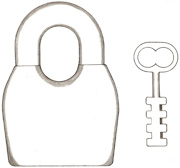 |
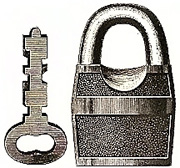 |
| American lock or Scandinavian Padlock. Made in the USA. Sketch by author. |
Scandinavian Padlock. Made in Eskilstuna by Låsbolaget in 1898. |
Ancient Greek lock. Lock on a temple door as described by Homer in the Odyssey, the 21st song: “And in her hand she carried a brazen key with a handle of ivory; and when she came to the door, she loosened the strap which served to draw the bolt from the outside, and inserting the key drew back the bolt.” The bolt was pulled back and forth using a strap hanging through a hole in the door, and was released using a large, curved key. Many variations of this kind of key have been found in archeological digs in Greece and elsewhere.
Anti-manipulation device. Used with combination locks to hamper attempts to open it without the correct combination. Can consist of buttons or bars that must be positioned before the rings in the lock can be turned.
Apple lock, spherical lock. Padlock with a spherical body and shackle. See the article on the History of padlocks.
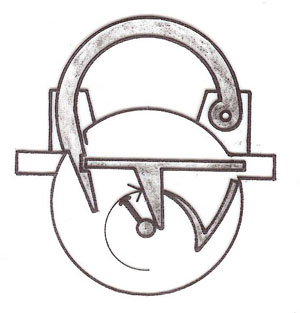 |
| Spherical lock. Sketch by the author. |
ASSA. ASSA was founded in 1881 by August Stenman. Today ASSA is a strong brand in the field of locks and integrated security systems nationally and internationally, with an established presence in the United States, UK, Netherlands, Baltic region, Germany, and Asia.
ASSA-ABLOY. Since 1994, ABLOY has been a part of the ASSA group.
ABCDEFGHIJKLMNOPQRSTUVWY
Bar iron. Iron produced directly from a blast furnace (pig iron) and refined – smelted again and pounded with helve hammers to reduce the carbon content. Bar iron was forged and stretched in many different places in Sweden, stamped and sold directly to the smiths, or exported.
Bar, beam. Simple locking device of wood or iron for single or double doors or gates. A bar can be placed in two brackets attached to the door or on both sides of it, then slid back and forth, or into a recess in the wall. Locking a door with a beam is the oldest locking principle and was invented along with the door. It is in fact still used today, so the concept of “bolted and barred” is still relevant.
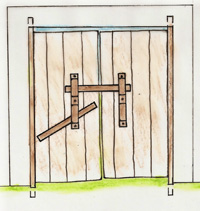 |
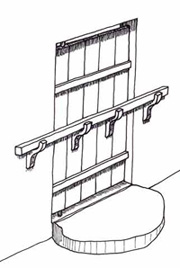 |
| Double bars |
Single crossbar |
Barrier lock, See the article on Safes and vaults.
Barron lock. Barrier lock for safe doors, designed and patented by Robert Barron in 1778. See the article on Safes and vaults.
Beam. See Bar.
Bench chest. Wooden bench with a seat/lid that can be raised to access storage inside. The front edge often has an eyelet closure that can be padlocked.
Bicycle key, see Bicycle lock.
Bicycle lock. The first bicycle – the velocipede – was designed by France’s Pierre Michaux in 1855. The modern bicycle with chain-operated gears and air-filled tires was conceived and developed in the 1880s, and was fitted with a lock almost from the start. The earliest locks consisted of a chain and a lock with a key. Padlocks with an extra long shackle were also sold; one of Sweden’s earliest mail-order companies, Åhlén & Holm, offered one in its 1899–1909 anniversary catalogue: “Velocipede lock no. 4493, of brass and the best American manufacture. To enclose one branch of the front fork and a few spokes, or the pedal crank arm and the adjacent frame arm.” Padlocks with an extra long shackle are still in use a century later. In the mid-20th century, several types of permanently mounted bicycle locks were introduced, and since the 1980s a long, sturdy chain with a padlock is also used (to lock the bike to something external).
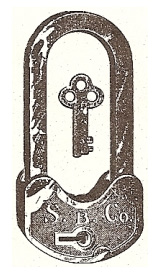 |
| Velocipede lock with extra long shackle, in the Åhlén & Holm 1899–1909 anniversary catalogue. |
Birka. An ancient settlement on the island of Björkö in Lake Mälaren in Sweden. When the trading center of Helgö declined, Birka arose, just 10 km away. It is thought that merchant trade was moved to Birka in the 9th century because the king wanted to pursue trade outside the nation’s boundaries and the sea-faring ships of the day, cogs, needed a deeper harbor than Helgö could offer. Its position also gave Birka better conditions to grow to a city. Archeological studies since the late 19th century have turned up large numbers of keys, locks and parts of locks. See the article on the History of keys.
Bit. The part of a key that acts directly on the locking mechanism, moving it to open or closed position.
Björkö. See Birka.
Bolt spring. Presses against the bolt of a lock to keep it in locked position.
Blacksmith welding. See Forge welding.
Blast furnace. For production of malleable iron using one or two blowers. These furnaces were built directly on the ground and were heated with charcoal. The ore was red earth or bog iron ore. Common throughout Sweden from the Viking Era until well into the 19th century.
Blocking mechanism. See Lock
Blue tempering. Decoration and rust protection of iron or steel surfaces. The method is simple; the smooth-filed surface is polished and heated to a deep blue color, which remains after cooling.
Bolt. See Lock.
Book lock. Padlock with a chain to protect valuable, handwritten books in Cloisters from theft in the Middle Ages.
Bow, Grip. See Key.
Box of wards. Forged protective device for the key tip in a door lock.
Bramah lock. A barrier lock for safe doors, designed and patented by Joseph Bramah in 1784. See the article on Safes and vaults.
ABCDEFGHIJKLMNOPQRSTUVWY
Castle locksmiths. Locksmiths who worked at manor houses or castles. They were specially invited because of their superior skill and fine sense of design. They were outside the regulations of the guild and were freed from being called out to war.
Celtic keys. See the article on Viking-Era keys.
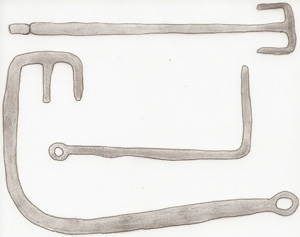 |
| Celtic keys. Sketch by the author. |
Chamber lock, rim lock. Spring-bolt lock or latch built into a square iron box and mounted on the surface of the door, on the inside. Originally opened with a door handle and key, later with a door knob and key. Manufactured from the 17th to the 19th century.
Chamberlain’s key. In the 18th and 19th centuries, a chamberlain’s key symbolized the high position of a chamberlain in a royal court or with the nobility.
Chasing. A method of decorating metal by imprinting, embossing, etching or treckning raising (a combination of embossing and stretching). The result is a decorative pattern in the metal created with a hammer and punches. The method was primarily used in the 16th and 17th centuries to decorate items such as door locks.
Cylinder lock. See Yale.
Chastity belt lock. Lock on a metal girdle or belt that was attached over a woman’s genitals. Spoken of from the 13th century and throughout the Middle Ages.
Chest, storage chest. See the article on Locks for chests and boxes.
Chest lock. See the article on Locks for chests and boxes.
Chinese padlock. A padlock of brass or bronze, usually with two ward springs and an arched shackle, often box-shaped but also in the shape of animals and many other forms.
Chubb lock. A barrier lock for safe doors, designed and patented by Jeremiah Chubb. See the article on Safes and vaults.
Church lock. See the article on Church keys.
Circular spring. Sturdy circular spring common in chest locks in the 16th–19th centuries.
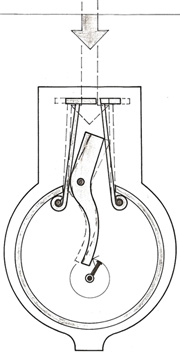 |
| Circular spring in a chest lock. Sketch by the author. |
Clamp. See Clasp.
Clasp. U-shaped piece of iron or steel with pointed shanks, usually used with a lock hasp.
Clock key. Key for winding clocks.
Cloverleaf. See Quatrefoil.
Code lock. See Combination lock.
Coin lock. Automatic locking device that came into use in the early 20th century for selling goods out of automatic dispensers. The mechanism in these early locks was a lever that was moved by the weight of the coin or token as it dropped, which moved the barrier aside. The machines could also be fitted with an electromagnet instead of a lever, which was triggered when the right coin was inserted. After the product was removed, the current was interrupted again. The same kind of locks were used in household gas meters (with tokens) and the meters showing how much gas and electricity have been used.
Combination lock 1. Letter or number combination lock.
Combination lock 2. See the article on Safes and vaults.
Copper plating. The ability of melted copper to unite with iron is a useful trait, not only for welding iron, but also for protecting and decorating an iron surface. The item to be plated has bits of copper placed on it and is then coated with fire-proof clay. The piece is fired and the copper melts and spreads over the whole object. Brass can also be used for this. Another method of copper plating is to submerge the iron object in copper vitriol.
Covering plate. Hides the internal workings of a lock.
ABCDEFGHIJKLMNOPQRSTUVWY
Decorative door lock. A door lock with decorations on the visible front part.
Door handle. In Sweden, doors have had turning handles made of iron or another metal since the 16th century.
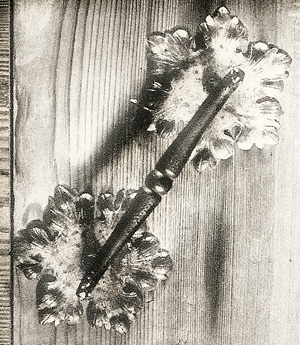 |
| Door handle in Duke Karl’s Chamber at the Gripsholm mansion. |
Door knocker, door ring, pull ring
Usually ring-shaped handle of iron or other metal used to pull open or knock on a door. Many Medieval Swedish churches have examples of exquisitely beautiful doorknockers. See also Door ring.
Door lock. See: Spring latch, Tumbler lock, Chamber lock and Mortise lock.
Door ring. Usually a simple closing tool of bronze, cast iron or wrought iron. Starting in the Middle Ages, doors had a handle on the front in the shape of a ring, wrought of iron or later cast in some other metal. The smooth wrought-iron rings on Medieval Swedish church doors sometimes featured dragon heads biting fast at the top, other times were a simple profiled ring. By the end of the Middle Ages, the rings became increasingly ornate. The fittings were often quadratic, sometimes perforated; the rings had round or square perforations and were sometimes spiraled. The original purpose of door rings was surely to serve as a handle for opening the door, but they could also be used to knock at the door, which later became their primary use. See also Door knocker.
Dowels. Free-moving locking parts (pins) in wooden locks.
Duhamel du Monceau. Author of Art du serrurier, Description des arts et métiers [Art of the Locksmith, Description of Arts and Professions], printed in Paris in 1767. Using clear pictures, the author describes the conditions for locksmiths in the latter half of the 18th century, which locks were in demand and how they were designed.
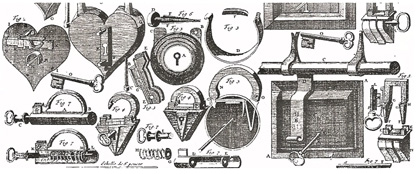 |
| Duhamel du Monceau 1767. From Art du serrurier, Description des arts et métiers. |
ABCDEFGHIJKLMNOPQRSTUVWY
Electric (electromechanical) lock. The bolt is maneuvered by an electric motor. Electric locks were around as early as the 1920s, mainly on outer doors to apartment buildings, etc. They consisted of a standard door lock and a striking plate on which one side could be turned by an electromagnet. When you press the button, the magnet turns the striking plate aside so that the bolt can be drawn and the door can be opened. When the bolt is shot back into closed position, the current is broken and the striking plate becomes immobile again. Breaking the current to the magnet ensures that the lock can only be opened with a key. (Uppfinningarnas bok [The Book of Inventions], Stockholm 1926.)
Electronic lock. Based on a system of scanners and a control unit that assesses the codes scanned. The electronic codes are stored magnetically on cards or in combination with a mechanical key in a chip. There are also scanners for personal codes, fingerprints, voice or retinal patterns. The electronic code is read by the scanner, processed by the control unit, which checks it against the preprogrammed code and then sends a signal to the motor-powered bolt or latch, electromagnetic bolt or handle, or electronically controlled striking plate. See also Electric lock.
Engraving. A method of decoration in which grooves are cut into a metal (or wood) surface with a sharp cutting tool called a burin or graver. There is no raised edge, as there would be with impressing. The engraved line is soft and unbroken, while the impression is composed of a series of pressed-in markings.
Erik Persson. Farmer Erik (or Erich) Persson (1707–1794) lived in Bollsjö in the parish of Folkerna in the province of Dalarna in central Sweden. He was a skilled jack of all trades who manufactured padlocks, bells, clocks, boxes, knives, hand axes and perpetual calendars, while still managing his farm.
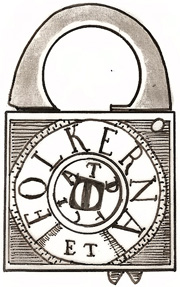 |
| Erik Persson’s padlock. Sketch by the author. |
Escutcheon. See Key plate.
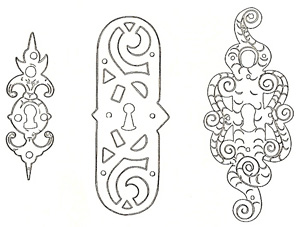 |
| Escutcheons from the Early Vasa Era. |
Eskilstuna as an industrial city. Eskilstuna Fristad, a free artisan’s town, merged with Eskilstuna in 1833 under the name Eskilstuna (fri)stad. In 1907 the smithing community of Tunafors was incorporated. Each individual company manufactured hundreds of products of iron and other metals, including many types of door locks, chamber locks, padlocks and fittings. Improved machinery in the mid 19th century allowed the companies to speed up manufacture. See the article on Eskilstuna, city of smiths.
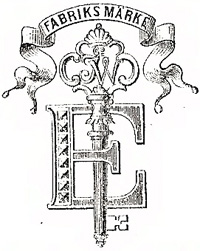 |
| Johan Walén & co, Eskilstuna |
Espagnolette. Turnable bolt for doors and windows. Manufactured from the 18th century on.
Etching. Locks have been decorated with etching since the 16th century. The fine-ground and polished iron surfaces were coated with an acid-resistant substance and the uncovered surfaces were then burned away using acid.
ABCDEFGHIJKLMNOPQRSTUVWY
Fetterlocks. A simple kind of padlock with ward springs and a large arched shackle, which was used until sometime in the 19th century to hobble cows and horses.
Filing. Surface treatment of locks, including masterpieces, using a range of fine files. The finely filed surfaces were usually polished.
Fittings. In this context, decorative reinforcements of iron or other metal on doors (hinges), windows, shutters, chests, furniture and so on.
Fixed lock. Permanently mounted locks, screwed or bolted to a door, chest, etc., as opposed to padlocks.
Forge welding, blacksmith welding. The oldest method of welding in ironsmithing. Two or more pieces of iron are heated white-hot and can then be joined by striking with a hammer or maul. This technique has probably been known ever since humans learned to produce iron. It has been replaced with welding in the modern era.
French lock. The predecessor of our chamber locks, manufactured in France and England in the late 17th century. The entire lock mechanism is enclosed in the lock housing and the mechanism is like a pin tumbler. The key, with its solid metal shaft, can be inserted into the box of wards from either side.
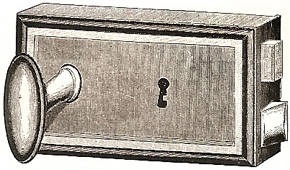 |
| French type of door lock. Manufactured by Låsbolaget in 1898. |
ABCDEFGHIJKLMNOPQRSTUVWY
Gate latch. Closing mechanism of wrought iron with a knob or turning handle, no key.
Gothic locks. Door locks manufactured in the late Middle Ages. The escutcheons often feature the typical Gothic trapezoidal shape, decorated with foliage around the keyholes.
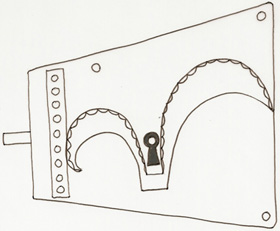 |
| Gothic door lock. Sketch by the author. |
Gotland
An island in the Baltic, belonging to Sweden. Throughout the 20th century, archeologists have found large quantities of bronze and iron keys in all the known Viking-Era shapes on Gotland. These finds also show that there was great variation in the shapes of keys to the same type of lock. See the article on the History of keys.
Grotesque. The original designation of a decorative style developed by Raphael and his school in the Vatican, based on Roman wall decorations. It consists of spiral vines and strange, unlikely masks, torsos, human figures and animals, with the architectural elements united by flowers, garlands and arabesques to symmetrical patterns. Among the most famous grotesques are those in the loggias of the Vatican. Grotesque art spread to the rest of Europe and was revived in the classicist period.
Guild system. The life and work of locksmiths were regulated in the guild rules that authorities had stipulated since the Middle Ages. Locksmiths were first part of the blacksmiths’ guild, but later had a guild of their own. One guild rule was that locksmiths had to set up their business in the towns. While they did enjoy a lack of competition there, the mayors and councils set their prices. In addition, orders had to be completed on time.
Guild chest. Used to store the guild charter and ceremonial vessels.
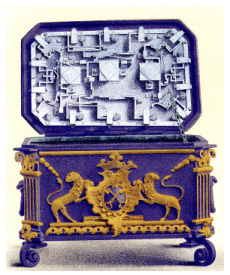 |
| Guild chest of the Stockholm smiths guild, dated 1737 and manufactured by castle locksmith Daniel Hamm. The bolts, as the picture shows, were maneuvered by three keys from the top of the lid. Original photo owned by the author. |
ABCDEFGHIJKLMNOPQRSTUVWY
Hammered inlay. A (rare) method of decorating an iron surface with precious metals, by hammering them onto the roughened surface.
Hammerska collection. Christian H. Hammer (1818–1905) was jeweler to the King of Sweden, as well as a real estate agent and a great collector. He was born in Christiania, Norway (modern-day Oslo), and was a journeyman goldsmith there in 1838, arriving in Stockholm in 1849–50. For 25 years, Hammer built up two fully catalogued collections – one on art history and one on applied (industrial) art. In total he had some 100,000 objets d’art and over 100,000 volumes of books, autographs and handwriting samples. The cultural collections were displayed and organized in a private museum in the Byströmska House, Hammer’s apartment in Stockholm, and in Furusund. The collections were auctioned off in Cologne in 1892–1893 after first being offered to the Swedish government. The popular magazine Familje-Journalen, volume XIII, 1874, issue IV, states that the collections were practically a museum of applied arts, with paintings and objects made of wood, metal, stone, glass and more. Hammer showed his collections to interested visitors himself. The Nordiska Museum bought a large number of the many locks and keys in his collection.
Handcuffs, hand irons, wrist shackles. See Leg shackles.
Handle 1. See Door handle.
Handle 2. Lock handle.
Helve hammer, trip hammer. Mechanical blacksmith hammer for producing bar iron. Powered by waterwheel. See Bar iron.
Helgö. Island in Lake Mälaren, Sweden, with the remnants of terraced house foundations, grave fields and ruins resembling an ancient fortress. Archeological digs have been conducted there since 1954. Finds and ruins have been dated from the late Roman Iron Age to the end of the Viking Era, including rich finds of parts of locks for boxes and chests. Various types of padlocks and keys indicate trade over long distances and skilled local artisans. See the article on the History of keys.
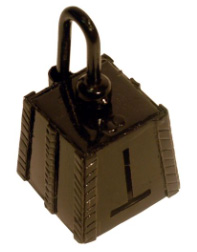 |
| Padlock of a type used on Helgö during the Viking Era. Photo by the author. |
Hidden keyhole. See the article on Safes and vaults.
ABCDEFGHIJKLMNOPQRSTUVWY
Iron. 1. Mild carbon steel, a malleable metal that could not be tempered, was historically called iron in Swedish. 2. Iron is an element, ferrum (Fe) with atomic number 26, atomic weight 55.85, density 7.87 and a melting point of 1,536 degrees C.
Ironclad chest. See the article on Locks for chests and boxes.
ABCDEFGHIJKLMNOPQRSTUVWY
ABCDEFGHIJKLMNOPQRSTUVWY
Karl Gustav Stad factories. Eskilstuna in the 18th century – the City of King Karl Gustav.
Key. The key is an instrument programmed or encoded through the shape of the bit to match the pins and wards of the lock. The key is a complex combination of technology, mechanics, design and choice of materials to achieve the primary task of moving a bolt to open or closed position, usually by turning the key – transferring the lateral force of the key bit to the bolt of the lock.
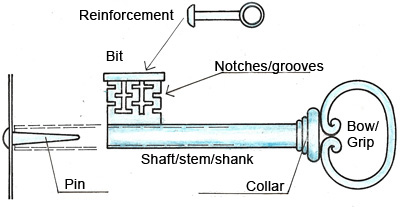 |
| Key |
Key bearer. From the Viking Era and a long time afterward, when a woman married, she became the key bearer, responsible for the family’s treasures, and she wore the household’s keys on her dress as a symbol of her power. Marriage ceremonies that included the handing over of keys were still taking place in some parts of Sweden in the late 19th century.
Key bow, Key grip. See Key.
Key cabinet. Usually a wall-mounted cabinet of metal or wood for storing keys. With hooks inside and labels indicating what locked area each key opens.
Key claws. (Tooth-like) notches on the key bit. Found on Viking-Era keys and on the bits of keys to pull locks from central Sweden.
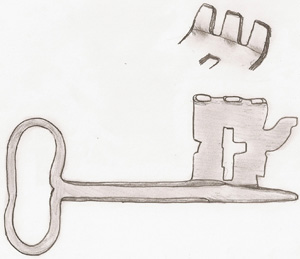 |
| Key to a pull lock. Sketch by the author. |
Key grip, Key bow. See Key.
Key of St. Peter. One or more keys. According to the New Testament, Jesus put Peter in charge: “And I will give unto thee the keys of the kingdom of heaven” (Matt 16:19). Those “keys” symbolize authority (Isaiah 22:15-25, Rev 1:18), which was later given to the Pope. Christ is the invisible head of the church, the Pope is the visible head. See the article on Church keys.
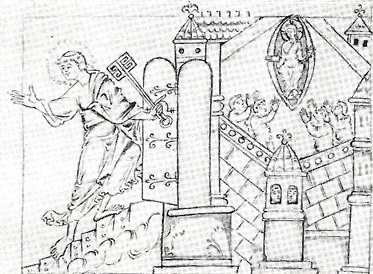 |
| Peters struggle with the devil and the condemnation of the damned. From the Benedictional of St. Ethelwolds, Winchester. British Museum, London. 10th century. |
Key pin. See Key.
Key plate. Decorative plate of metal, iron, bone or wood surrounding a keyhole.
Key stem. See Key.
Key shaft. See Key.
Key to the city. The keys to the city gates were a symbol of the inhabitants’ right to self-determination.
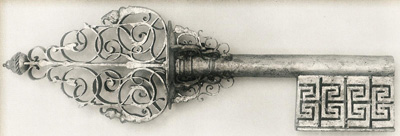 |
| Key to the City of Stockholm. |
Key to the Kingdom. Swedish King Erik XIV’s Key to the Kingdom is a symbol of power and a part of the royal regalia. Manufactured by Dutch goldsmith Peter Holtswiller of gilded silver, the key is a classic example of the style of the Vasa Renaissance. Its symbolic meaning is to “unlock and lock, and preserve all that is good.” The key weighs 676 grams and measures 43 cm in length. Stored in the Treasure Chamber of the Royal Palace in Stockholm.
Keyhole. 1. The hole through which a key is inserted in a lock, often with a corresponding hole on the opposite side of the door so that a key can be inserted from either side. The hole is usually covered by an escutcheon of iron, another metal, etc. 2. Pipe in the shaft/stem of a key.
Keyhole block. Is placed in a keyhole and locked in place.
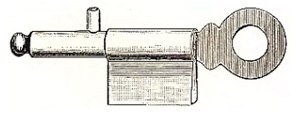 |
| Keyhole block |
Keyring, Keychain. A metal ring or similar contrivance to hold a group of keys.
Keys to heaven. See the article on Church keys.
ABCDEFGHIJKLMNOPQRSTUVWY
Latch-lifter. Usually a forged key for a wooden sliding-bolt lock. These locks open and close via a key with a long, narrow bit at a right angle to the shaft (latch-lifter), which is inserted into a hole above the bolt and turned. The key bit moves the bolt using the notches, pins or holes on the bolt.
Lavatory key. In cities in Sweden and elsewhere in Europe, apartment buildings could have communal lavatories in the corridors, or rows of outdoor lavatories in the courtyards as late as the 1940s, built in the latter half of the 19th century. The lavatories were locked, and were often intended for several households, each with its own key.
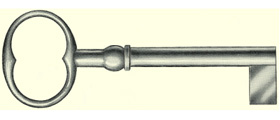 |
| The most common lavatory key in Sweden. |
Leg shackles. Rings of wrought iron, usually used with hand irons and neck irons, all locked with padlocks.
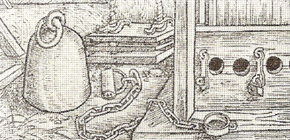 |
| Leg shackle with chain and padlock. Detail of a picture from Nuremberg, Germany, 1517. |
Lessee lock In Sweden, an early designation for the replaceable locks on items like safe-deposit boxes. The interchangeable lock cores developed by Rosengrens in the early 1920s were designed to fit into safes, safe-deposit boxes (bank boxes) and more. See the article on Safes and safe-deposit boxes.
Letter combination lock. See Combination lock.
Lock. A lock is a mechanical device used to prevent the opening of a door, etc., without the proper key. The lock is a complex combination of technology, mechanics, electronics, digital technology, design and choice of materials to achieve the primary task of moving a bolt to open or closed position, usually by turning a key – transferring the lateral force of the key bit to the bolt of the lock. Locks come in a huge number of designs meant for different uses, such as door locks, padlocks, car locks, cabinet locks, safe locks, coin locks, etc.
Lock body. Housing for the lock mechanism. They were often decorated on top in the 17th and 18th centuries.
Lock bolt, See Lock.
Lock housing. See Lock body.
Lock pick. The specialized tool used to pick a lock. It is not illegal to pick a lock in Sweden as long as it is your own lock. However, in public places only trained locksmiths on duty are allowed to carry picks. The first time lock picks and unpickable locks are mentioned in connection with Swedish locks is in the marketing of Christoffer Polhem’s padlocks, called Polhem or Scandinavian locks.
Lock pin. See Key.
Locking bar. See Lock.
Locking bolt, locking bar. See Bolt.
Locking device, Technological tool with a limited function for closing, barring, etc.
Locking mechanism. System of coordinated (mechanical) parts that make up the operating force of a lock.
Locksmith. Historically in Sweden, a distinction was made between blacksmiths (who made horse shoes, tools and nails), gunsmiths, and armor makers on the one hand, and makers of fine ironwork, who made locks, keys, fittings, latticework, and other more ornamental items. For the sake of simplicity, they are called locksmiths here. From the 15th century on, locksmiths gained a privileged status in society. See the article on The locksmith’s workshop.
Lund. A large number of locks and keys from the early Middle ages were turned up when the streets of Lund in southern Sweden were dug up for sewer lines in 1881 (see Kulturens årsbok 1940) and in archeological studies conducted prior to major construction projects of the 1960s and 70s (the Thule insurance company and PK-banken). Corresponding types of locks and keys have also been found in many other locations in Sweden and Denmark.
ABCDEFGHIJKLMNOPQRSTUVWY
Master key. Key that opens all the locks in a lock system, whether for a single building or a whole residential area.
Masterpiece. In Germany and the Nordic region, a masterpiece consisted of three locks: a door lock, a chest lock and a padlock. In the 17th century, masterpieces became a proof of skill, with exquisite filing but no practical use. Masterpieces were given three stamps on passing inspection. Often they went on to be included as works of art in fancy armories or curio collections.
Mortise lock. A thin lock housing that is inserted and fastened in an opening (mortise) in the front edge of the door. The lock is completely protected by the door.
Mästermyr. Mästermyr is a moor on the island of Gotland. In 1936 a farmer was plowing the land and discovered a wooden tool chest, 90 cm long and 24 cm high. In and around it were over 200 smith’s tools and iron objects.
ABCDEFGHIJKLMNOPQRSTUVWY
Numeric combination lock. See Combination lock.
Nya Lödöse. A settlement dating back to the 11th century. Rich finds of keys and locks from archeological digs done in 1916–20 and later. See Lödösefynd, 1994 / Rune Ekre et al.
Nyköping Banquet. Eric’s Chronicle, written in the 1330s, is one of a series of medieval chronicles of the kings of Sweden. A large part of it is about the Nyköping Banquet, a grisly drama in which a key played a crucial role. A tale of power struggle, schism, injustice, revenge and cruel death that unfolded in the Nyköping Fortress in 1317. See the article on the Nyköping Banquet.
ABCDEFGHIJKLMNOPQRSTUVWY
Obstructions. See Wards.
Oil painting. A simple, sure way to treat and protect iron. The method has been used in Sweden since the Vasa Era.
Original. Object that is the basis of a hand-made copy.
Ornamentation. Decorations, stylized decorative patterns that utilize and emphasize the basic shape of an object. Can be in relief, carved in or painted on.
Oseberg ship. A Viking ship found in a large burial mound at the Oseberg farm near Tønsberg in Vestfold county, Norway, in the early 20th century and excavated by archeologists. Built in the first half of the 9th century, the ship contained rich finds, including locked chests with spring-loaded shackles.
ABCDEFGHIJKLMNOPQRSTUVWY
Padlock. See the article on the History of padlocks.
Papal keys. See the Key of St. Peter and the article on Church keys.
Patent lock. See Cylinder lock.
Permutation lock. A combination lock for safes designed by G Schnitzer in Stuttgart. The lock opens when rings b, c, d and e are turned so that their catches align with the one in ring a, forming a specific code. After that, ring a is turned to the right to open the lock.
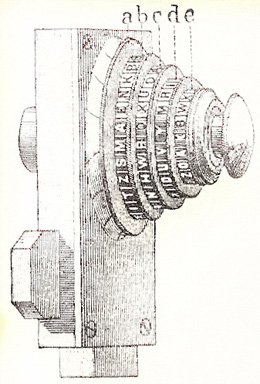 |
| Permutation lock by G Schnitzer, Stuttgart. |
Pig iron. The carbon-rich iron that was produced in puddling furnaces. See Bar iron.
Pin cylinder lock. See Cylinder lock.
Pin tumbler lock. Lock usually of wood with loose tumblers, a wooden bolt and a wooden key. The tumblers consist of pins that block the sliding of the bolt. A key with dowels on the top lifts the tumblers to release the bolt. This type of lock comes from the Near Orient and Egypt, and spread across Europe from the Roman Era on. Wooden pin tumbler locks were used in large parts of Sweden on outbuildings as late as the 19th century.
Puddling furnace. Iron ore was converted into wrought iron by smelting, or “puddling” it in blast or puddling furnaces. The blast furnace consisted of a bricked pipe, open at the top and surrounded by timber walls in a square. The space between the pipe and the walls was filled with clay and stone. At the bottom were openings for tapping (emptying out) slag and ore, and a nozzle or tuyere for blasting in air using water-powered bellows. The process began by filling the bottom of the furnace with charcoal, followed by a mix of crushed, roasted ore and charcoal. Crushed limestone was also included to make the slag run off more easily. The furnace was lit and the bellows pumped in air, intensifying the heat and speeding up the burning process. The ore bonded with the carbon in the coal, releasing oxygen and other gases, which passed out through the top. The melting point of the iron decreased when the carbon bonded with it (about 4%), and soon the smelt iron began collecting in the bottom while the more fluid slag lay on top of it. The iron and slag were tapped alternately. The pipe was continuously filled with ore, charcoal and limestone as long as the “blasting” went on.
Puddled iron, Osmund iron. Wrought iron that has been refined in a puddling furnace or blast furnace but not yet welded.
Pull bolt lock. A group of locks consisting of a horizontal wooden bolt that slides side to side on iron or wooden staples. These locks open and close via a key with a long, narrow bit at a right angle to the shaft (latch-lifter), which is inserted into a hole above the bolt and turned. The key bit moves the bolt using the notches, pins or holes on the bolt.
Pull lock. Many local smiths in the Swedish province of Dalarna made special iron “pull locks” for storehouses and lofts. The long locks are often signed and decorated with etching and rounded embossments. To open them, you maneuver the key with one hand while pulling a ring to draw the bolt with the other (hence the name “pull lock”) See the article on Pull locks from Dalarna and surrounding provinces.
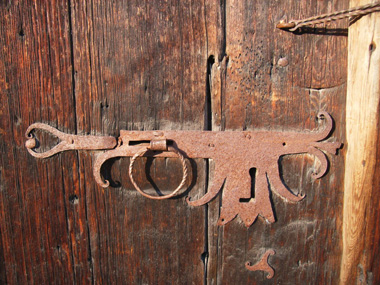 |
| Pull lock at the artist Anders Zorn’s Gammelgård farm in Mora. The Bergkarlås barn, 1312–13. Photo by the author. |
Pull-lock key, with tooth-like notches on the bit. Each tooth corresponds to a spring in the lock. See (fig.) Clawed keys
Pull ring. See Pull lock.
Punishment for theft. In the Middle Ages, fines were the most common punishment for theft, and one that was not considered dishonorable. More severe cases could be punishable by flogging, the cutting off of one or both ears or a hand, or death by hanging. Even the loss of an ear made the perpetrator’s shame permanently visible.
The thievery code in the Dalarna law called for a fine of three marks for pilfering one öre (a mark was worth eight öre). The fine applied whether or not legal action was taken. The fine for stealing a half mark was 40 marks. See the article on Theft and punishment.
Push key. Another name for a key to a padlock with ward springs (spring locks). It pushes down the springs to open the lock.
Provincial laws. The law rolls of the Swedish Provinces were written down in the 13th century. These naturally included the punishment for theft. This early medieval legislation distinguishes generally between wrongs committed against the social order and those committed against individual interests. For example, outlawry was heavily punished; anyone had the right to put an outlaw to death. See the article on Theft and punishment.
Protector lock. An early 1850s lock design by renowned American locksmith Alfred Charles Hobbs, who was the first man to be able to pick the “unpickable” six-levered Chubb detector lock at the 1851 World Fair in London (the Great Exhibition). A German locksmith and inventor, Theodor Kromer from Freiburg, designed a protector lock in 1874 based on the Chubb principle with several lever tumblers but without springs. See the article on Safes and vaults.
Polhem lock. See the article on Christoffer Polhem.
Portmanteau lock, trunk lock, suitcase lock. A simple lock with a catch that snaps down.
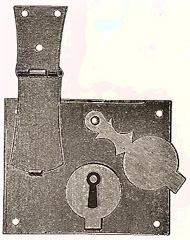 |
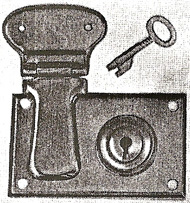 |
| Portmanteau lock |
Suitcase lock |
ABCDEFGHIJKLMNOPQRSTUVWY
Quatrefoil. A Gothic architectural ornament having four lobes or foils.
ABCDEFGHIJKLMNOPQRSTUVWY
Ribs. Reinforcements of the body of a padlock with narrow bands of iron welded on.
Rim lock. See Chamber lock.
Ring key. Roman key designed to be worn on the finger as a ring.
ABCDEFGHIJKLMNOPQRSTUVWY
Scandinavian Padlock. See American lock.
Screw padlock. A type of padlock with ward springs and a screw mechanism that compresses the springs. See the article on the History of padlocks.
Shackle. Fixed, separate or mobile part of a padlock. Usually arched with two legs.
Shield-shaped padlock. Originally decorative locks with one, two or four shackles. Attractive, strong and heavy, weighing from two to nearly five kilograms. The lock bodies were smooth and carefully filed, polished and blue-tempered. The shackle or shackles are locked by a spring-loaded bolt actuated with a turning key. The keyholes are sometimes hidden under a flap. The earliest such locks in Sweden were imported from Germany during the Vasa Renaissance or were manufactured in Sweden by smiths trained in Germany. See the article on the History of padlocks.
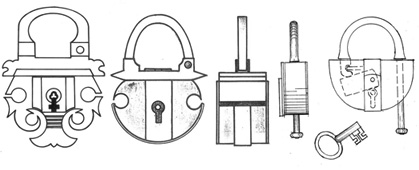 |
| Example of the development of shield-shaped padlocks. Sketches by the author. |
Sliding bar. See Bar.
Sliding bolt. See Bolt.
Spartan keys (also called elbow keys). Named for one site where they have been found. Similar keys were used throughout the Middle East, including Egypt and Israel. The key was inserted through a hole in the door and the teeth on its bit moved the bolt.
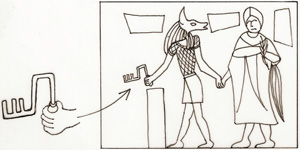 |
| The Egyptian god Anubis (as a companion) with a Spartan key. Circa 100 AD. Sketch by the author. |
Spherical lock, apple lock. Padlock with a spherical body and a shackle. See the article on the History of padlocks.
Spring latch. From the Vasa Renaissance on, spring latches became common on doors, closets and cupboards. They can have one or more spring-loaded latch bolts with a beveled front edge to allow the latch to be pushed in by the door and then snap out again into the door jamb. Also called a slam latch or slam lock.
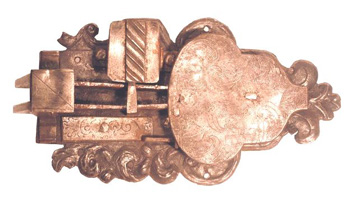 |
| Spring latch from Raine Borg’s collection. Photo Niklas Woermann. |
Spring latch lock. Barrier lock based in part on the Chubb lock principle, with a handle, latch bolt and locking bolt in the same housing. The latch bolt has the typical beveled edge.
Spring padlock. A padlock with springs. See the article on the Vendel era.
Spring padlock key, push key. Key to a padlock with springs. The keys are usually made of bronze or iron.
 |
| Iron key for a padlock with double ward springs. Sketch by the author. |
Springs. Springs have been crucial to the design and function of locks throughout history. The Romans used springs as wards in padlocks and in pin tumbler locks. Ward spring locks are found in Scandinavia from the Viking Era until well into the 18th century. Various types of springs could also be used in the locks on doors and chests. Prior to 1600 they were V-shaped; after that they were spirals. The early springs were made of cold-hammered iron, making them very rugged. Trunk locks generally have ring-shaped springs.
Staple. See fig.
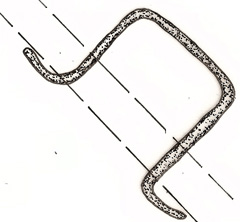 |
| Staple |
Steel. Steel was the name for any iron-carbon alloy that could be tempered.
Stem. Shaft of a key, see Key.
Stjernsund. Christoffer Polhem’s factory facilities were built on the site of an old foundry and hammer smithy. The name of the place was changed to Stjernsund after Gabriel Stierncrona and the place itself, Sund. These works became Polhem’s experimental workshop and did not make any major profits. See the article on Christoffer Polhem.
Striking plate. Flat metal plate fixed to the door frame or jamb with one or more bolt holes into which the bolt or bolts shoot.
Styria lock. Barrier lock with a thin, collapsible toothed key.
Swiss Guard. In 1512, Pope Julius named the Swiss Guard the official Defender of the Freedom of the Church, presenting them with two standards: one bearing the Papal symbol of the crossed keys, one bearing the tiara, the keys and the coat of arms of his own family, della Rovere. Since the 13th century, the popes have had a coat of arms with two crossed keys, one silver, representing earthly power, and one gold, representing spiritual power.
ABCDEFGHIJKLMNOPQRSTUVWY
Tempering, Annealing. A decorative and protective method of highly polishing iron and steel. The metal is heated, tempered and oxidizes to various colors: yellow, red, violet, blue and blue-green, in that order. If the heating process is interrupted at a given color, that color remains. Blue-tempered steel is the most common. The method has been used as early as the 16th century.
Temple lock. Door lock in the form of a bar (bolt) placed on brackets on the inside of the door. To unlock it, a giant, bent metal key was inserted through a hole in the door to move the bar. To shoot the bolt, you pulled a small rope or leather strap to slide the bar into the bracket on the door frame. For more information, see the article on Locks of wood and iron.
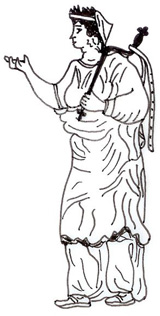 |
| Greek woman with a bent bronze key. Sketch by the author. |
Time lock. See the article on Safes and vaults.
Tin plating. Method of surface treating locks and fittings by dipping them in melted tin.
Trefoil. Arched elements in Gothic architecture.
Triangular padlock. See the article on History of padlocks.
Trunk lock 1. See the article on Locks for chests and boxes.
Trunk lock 2. See Portmanteau lock.
Tumbler 1. A spring-loaded self-moving tumbler that automatically shoots the bolt.
Tumbler 2. See bolt.
Tumbler 3. See the article on Safes and vaults.
Tumbler lock 1. A lock with a spring-loaded self-moving tumbler that automatically shoots the bolt. This type of lock came into use in Sweden in the late 15th century.
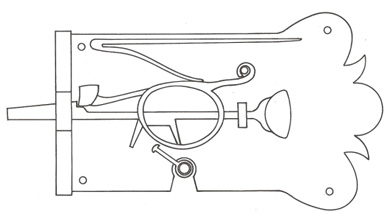 |
| Tumbler lock. Sketch by the author. |
Tumbler lock 2. A lock with a number of moving detainers (tumblers), whose shape matches the bit on the correct key. When the key is turned, the bit turns the bolt and lifts the tumblers to open a passage for the bolt. For more information, see the article on Safes and vaults.
Turning key. See key.
Turnkey lock. A permanently mounted lock body with a sliding bolt. The lock was placed on the inside of a door and was maneuvered with a key from the outside.
ABCDEFGHIJKLMNOPQRSTUVWY
Unpickable lock. A lock that cannot be picked.
Utility lock. Simple door lock.
ABCDEFGHIJKLMNOPQRSTUVWY
Värnamo. Town in the province of Småland in Sweden, where several keys with S-shaped bits were found in and around a grave field. All sliding-bolt keys with S-shaped bits are made of iron. The Museum of National Antiquities in Stockholm has eight Viking-Era keys with the same appearance, all from archeological digs in the Värnamo region. For more information, see the article on Viking-Era keys.
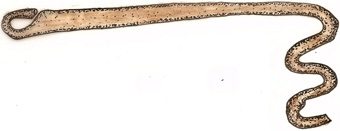 |
| Viking-Era key from Värnamo. Sketch by the author. |
ABCDEFGHIJKLMNOPQRSTUVWY
Ward. Obstruction that blocks the wrong key from entering a lock. See Lock.
Wards. Protrusions or obstructions, usually mounted in lock fittings or in the keyway. The correct key has notches or grooves in the bit for each ward.
Wooden block lock. A lock placed on the inside of a door, consisting of an iron bolt built into a hollow in a woodstock or a sturdy piece of hardwood. Usually the insertion point is covered with thin iron sheet. See the article on Locks of wood and iron.
Wooden lock. See the article on Locks of wood and iron.
Y
ABCDEFGHIJKLMNOPQRSTUVWY
Yale lock. A cylinder lock (previously called patent lock) invented in the 1840s by American Linus Yale Sr. (1797–1857). Just as in Christoffer Polhem’s padlocks, the cylinder lock consists of fixed and moving detainers. However, it is believed that he did not take the lock principle from a Scandinavian padlock (which were made in the United States), but from a wooden Egyptian pin tumbler lock, plus some of the technology of a Bramah lock, to create a whole family of complex locks.
His son, Linus Yale Jr. (1821–68) further improved the cylinder lock. With some modifications, this is still one of our most common types of locks, on doors, gates, padlocks and so on. Cylinder locks have been made in Sweden since the early 1880s. The principle is simple; releasing an internal cylinder from an external one so that the internal one can turn on its axis. To open the lock, several separate spring-loaded pin tumblers must be moved into position with the grooves in the side of the key. The key is small, thin and easy to carry in a pocket or key case. The safety of these locks has increased from the original four pins to today’s seven.
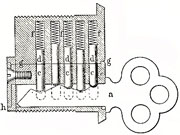 |
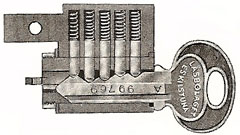 |
| Yale cylinder lock, 1880s. |
Cylinder lock, made by Låsbolaget, about 1945. |
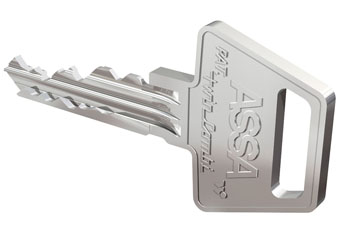 |
| Key to an ASSA Twin Combi cylinder lock, 2007. |